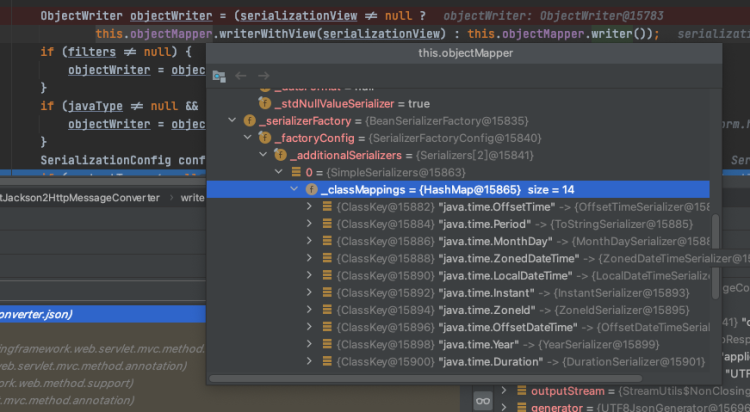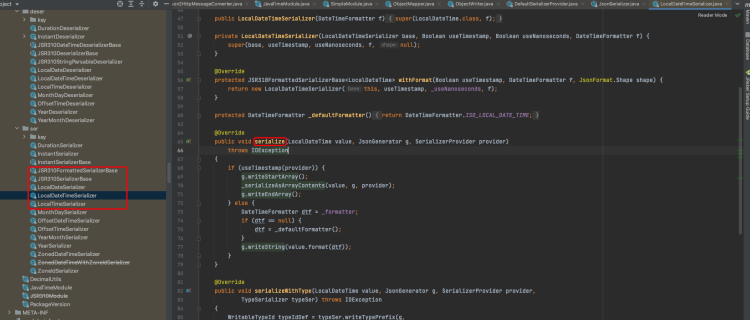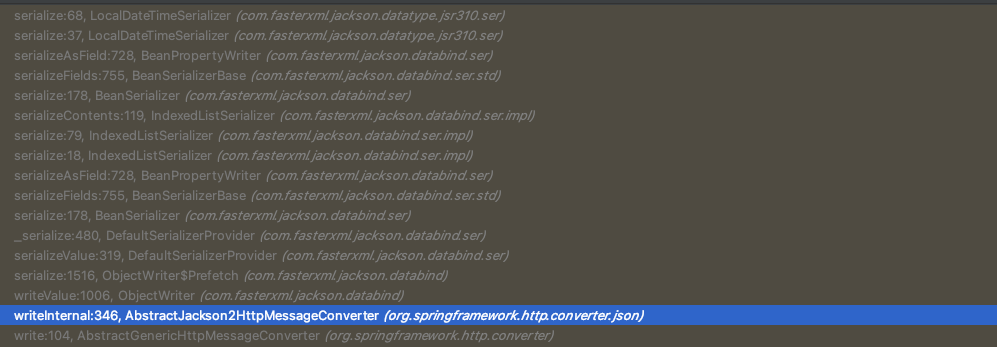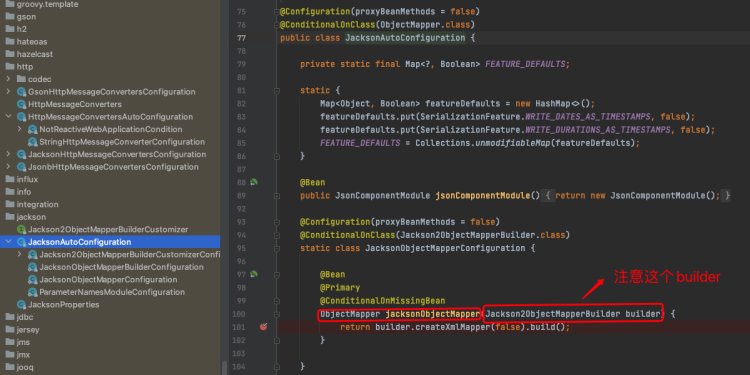JSR310-LocalDateTime序列化 & 反序列化
问题
springboot 版本:spring-boot 2.3.12
今天在开发一个redis 热key服务端的过程中,碰到2个问题:
- jdk8的LocalDateTime,LocalDate,LocalTime类型的字段在序列化,会被序列成["2021","12","22","18","56","40"]这样的数组;
- 服务接受请求LocalDateTime类型的参数时,要求参数为 "2021-12-22T18:56",中间加"T"(ISO-8601) 才能够正常实现反序列化,yyyy-MM-dd HH:mm:ss 格式的字符串反序列化会报异常,异常信息如下:
org.springframework.http.converter.HttpMessageNotReadableException: Invalid JSON input: Cannot deserialize value of type `java.time.LocalDateTime` from String "2021-12-22 18:56:40": Failed to deserialize java.time.LocalDateTime: (java.time.format.DateTimeParseException) Text '2020-05-04 00:00' could not be parsed at index 10; nested exception is com.fasterxml.jackson.databind.exc.InvalidFormatException: Cannot deserialize value of type `java.time.LocalDateTime` from String "2021-12-22 18:56:40": Failed to deserialize java.time.LocalDateTime: (java.time.format.DateTimeParseException) Text '2021-12-22 18:56:40' could not be parsed at index 10 // 省略部分异常信息 Caused by: java.time.format.DateTimeParseException: Text '2021-12-22 18:56:40' could not be parsed at index 10
系统默认的序列化&反序列化方式给人感觉比较反人类,给所有功能相关都会带来困惑和额外的转化工作量,需要使用一种更符合大家使用习惯的方式解决一下。
方案职责的定位
LocalDateTime序列化&反序列化的使用应该是应用服务的共性问题,发挥作用的层次在springmvc 的HttpMessageConverter层次,个人想法-解决方案应该放在基础框架或脚手架层次(如果所在公司又自己的框架或脚手架),这样所有使用框架及脚手架的应用都会因此受益。
解决过程
定位问题
spring boot 在mvc请求的处理过程中,负责json 格式序列化和反序列化的是Jackson*HttpMessageConverter,具体哪个类定位一下即可,所有的请求response在spring boot里统一在RequestResponseBodyMethodProcessor这个类的handleReturnValue方法中进行的。
@Override
public void handleReturnValue(@Nullable Object returnValue, MethodParameter returnType,
ModelAndViewContainer mavContainer, NativeWebRequest webRequest)
throws IOException, HttpMediaTypeNotAcceptableException, HttpMessageNotWritableException { mavContainer.setRequestHandled(true);
ServletServerHttpRequest inputMessage = createInputMessage(webRequest);
ServletServerHttpResponse outputMessage = createOutputMessage(webRequest); //这里即是使用各种MessageConverter对返回的对象进行序列化处理的地方
writeWithMessageConverters(returnValue, returnType, inputMessage, outputMessage);
}
顺着writeWithMessageConverters方法继续往下debug,最终找到了Jackson的converter -> AbstractJackson2HttpMessageConverter的withInternal方法。
@Override
protected void writeInternal(Object object, @Nullable Type type, HttpOutputMessage outputMessage)
throws IOException, HttpMessageNotWritableException { MediaType contentType = outputMessage.getHeaders().getContentType();
JsonEncoding encoding = getJsonEncoding(contentType); OutputStream outputStream = StreamUtils.nonClosing(outputMessage.getBody());
JsonGenerator generator = this.objectMapper.getFactory().createGenerator(outputStream, encoding);
try {
//此处忽略不相关的代码 //此处即是将返回对象序列化的objectWriter
ObjectWriter objectWriter = (serializationView != null ?
this.objectMapper.writerWithView(serializationView) : this.objectMapper.writer());
if (filters != null) {
objectWriter = objectWriter.with(filters);
}
if (javaType != null && javaType.isContainerType()) {
objectWriter = objectWriter.forType(javaType);
}
SerializationConfig config = objectWriter.getConfig();
if (contentType != null && contentType.isCompatibleWith(MediaType.TEXT_EVENT_STREAM) &&
config.isEnabled(SerializationFeature.INDENT_OUTPUT)) {
objectWriter = objectWriter.with(this.ssePrettyPrinter);
}
//此处开始进行序列化
objectWriter.writeValue(generator, value); writeSuffix(generator, object);
generator.flush();
generator.close();
}
catch (InvalidDefinitionException ex) {
throw new HttpMessageConversionException("Type definition error: " + ex.getType(), ex);
}
catch (JsonProcessingException ex) {
throw new HttpMessageNotWritableException("Could not write JSON: " + ex.getOriginalMessage(), ex);
}
}
objectWriter是真正执行序列化的,它是由ObjectMapper来创建的,再来看以下ObjectMapper,

关键的序列化组件由_serializerFactory提供,由内部提供了很多类型对象序列化支撑。

再继续跟踪,最终进入了LocalDateTime类型的序列化类->LocalDateTimeSerializer,通过serialize方法进行序列化,在包里我们还可以看到很多JSR310的日期类型的序列化类。
再来看serialize方法,其中有一个很重要的逻辑->useTimestamp方法,在父类JSR310FormattedSerializerBase中实现,单独摘出来
protected boolean useTimestamp(SerializerProvider provider) {
if (_useTimestamp != null) {
return _useTimestamp.booleanValue();
}
if (_shape != null) {
if (_shape == Shape.STRING) {
return false;
}
if (_shape == Shape.NUMBER_INT) {
return true;
}
}
//这里让人眼前一亮,意味着可以通过外置扩展的方式来给一个配置好的_formatter
return (_formatter == null) && (provider != null)
&& provider.isEnabled(getTimestampsFeature());
}
这个方法默认返回true,默认_formatter是null,provider.isEnabled也是true,这里我们应该已经找到解题之道了—我们可以试图给-LocalDateTimeSerializer一个定义好的_formatter,或者给定配置让它生成一个formatter.
整理一下调用链路

整理一下思路:LocalDateTimeSerializer->...->DefaultSerializerProvider->Prefetch->ObjectWritter->ObjectMapper
看一下不起眼的Prefetch的关键方法-_serializerProvider
protected DefaultSerializerProvider _serializerProvider() {
return _serializerProvider.createInstance(_config, _serializerFactory);
}
通过此方法将ObjectWritter中的_serializerFactory来创建一个默认的DefaultSerializerProvider。
好了,回过头来溯源已经清楚了,其实还是ObjectMapper来传入进去的。那么我们就研究在ObjectMapper创建时如何做一下扩展,将自己的扩展解决方案融入到ObjectMapper中就可以了。
解决方案
AbstractJackson2HttpMessageConverter的实现类MappingJackson2HttpMessageConverter,找到这个bean的创建位置

再看一下ObjectMapper的创建位置

如图所示,MappingJackson2HtttMessageConverter的ObjectMapper在JacksonAutoConfiguration中创建的,并且通过Jackson2ObjectMapperBuilder 来创建的,这个类很重要,我们看一下这个build方法。
public <T extends ObjectMapper> T build() {
ObjectMapper mapper;
if (this.createXmlMapper) {
mapper = (this.defaultUseWrapper != null ?
new XmlObjectMapperInitializer().create(this.defaultUseWrapper, this.factory) :
new XmlObjectMapperInitializer().create(this.factory));
}
else {
mapper = (this.factory != null ? new ObjectMapper(this.factory) : new ObjectMapper());
}
//这里的configure就是配置mapper的,做包括序列在内的各种配置的
configure(mapper);
return (T) mapper;
}
configure方法:
public void configure(ObjectMapper objectMapper) {
Assert.notNull(objectMapper, "ObjectMapper must not be null");
MultiValueMap<Object, Module> modulesToRegister = new LinkedMultiValueMap<>();
if (this.findModulesViaServiceLoader) {
ObjectMapper.findModules(this.moduleClassLoader).forEach(module -> registerModule(module, modulesToRegister));
}
else if (this.findWellKnownModules) {
registerWellKnownModulesIfAvailable(modulesToRegister);
}
if (this.modules != null) {
this.modules.forEach(module -> registerModule(module, modulesToRegister));
}
if (this.moduleClasses != null) {
for (Class<? extends Module> moduleClass : this.moduleClasses) {
registerModule(BeanUtils.instantiateClass(moduleClass), modulesToRegister);
}
}
List<Module> modules = new ArrayList<>();
for (List<Module> nestedModules : modulesToRegister.values()) {
modules.addAll(nestedModules);
}
objectMapper.registerModules(modules);
//此处省去不关注的代码
}
这个Module是个抽象类,有这么多实现,JavaTimeModule就是时间相关的模块

看一下JavaTimeModule说明
Class that registers capability of serializing java.time objects with the Jackson core.
ObjectMapper mapper = new ObjectMapper();
mapper.registerModule(new JavaTimeModule());
Note that as of 2.x, if auto-registering modules, this package will register legacy version, JSR310Module, and NOT this module. 3.x will change the default. Legacy version has the same functionality, but slightly different default configuration: see JSR310Module for details.
再看一下JavaTimeModule的核心代码,它的构造方法里加入了这么多的序列化及反序列化类,不过是都是默认的,我们需要使用JavaTimeModule创建一个我们需要的类。
public final class JavaTimeModule extends SimpleModule
{
private static final long serialVersionUID = 1L; public JavaTimeModule()
{
super(PackageVersion.VERSION); // First deserializers // // Instant variants:
addDeserializer(Instant.class, InstantDeserializer.INSTANT);
addDeserializer(OffsetDateTime.class, InstantDeserializer.OFFSET_DATE_TIME);
addDeserializer(ZonedDateTime.class, InstantDeserializer.ZONED_DATE_TIME); // // Other deserializers
addDeserializer(Duration.class, DurationDeserializer.INSTANCE);
addDeserializer(LocalDateTime.class, LocalDateTimeDeserializer.INSTANCE);
addDeserializer(LocalDate.class, LocalDateDeserializer.INSTANCE);
addDeserializer(LocalTime.class, LocalTimeDeserializer.INSTANCE);
addDeserializer(MonthDay.class, MonthDayDeserializer.INSTANCE);
addDeserializer(OffsetTime.class, OffsetTimeDeserializer.INSTANCE);
addDeserializer(Period.class, JSR310StringParsableDeserializer.PERIOD);
addDeserializer(Year.class, YearDeserializer.INSTANCE);
addDeserializer(YearMonth.class, YearMonthDeserializer.INSTANCE);
addDeserializer(ZoneId.class, JSR310StringParsableDeserializer.ZONE_ID);
addDeserializer(ZoneOffset.class, JSR310StringParsableDeserializer.ZONE_OFFSET); // then serializers:
addSerializer(Duration.class, DurationSerializer.INSTANCE);
addSerializer(Instant.class, InstantSerializer.INSTANCE);
addSerializer(LocalDateTime.class, LocalDateTimeSerializer.INSTANCE);
addSerializer(LocalDate.class, LocalDateSerializer.INSTANCE);
addSerializer(LocalTime.class, LocalTimeSerializer.INSTANCE);
addSerializer(MonthDay.class, MonthDaySerializer.INSTANCE);
addSerializer(OffsetDateTime.class, OffsetDateTimeSerializer.INSTANCE);
addSerializer(OffsetTime.class, OffsetTimeSerializer.INSTANCE);
addSerializer(Period.class, new ToStringSerializer(Period.class));
addSerializer(Year.class, YearSerializer.INSTANCE);
addSerializer(YearMonth.class, YearMonthSerializer.INSTANCE);
回过头来继续看Jackson2ObjectMapperBuilder的创建,在JacksonAutoConfiguration中创建
@Configuration(proxyBeanMethods = false)
@ConditionalOnClass(Jackson2ObjectMapperBuilder.class)
static class JacksonObjectMapperBuilderConfiguration {
@Bean
@Scope("prototype")
@ConditionalOnMissingBean
Jackson2ObjectMapperBuilder jacksonObjectMapperBuilder(ApplicationContext applicationContext,
List<Jackson2ObjectMapperBuilderCustomizer> customizers) {
//这里有Jackson2ObjectMapperBuilderCustomizer,意味着我们可以通过自定义它的Cutomizer,
//来做一下个性化扩展
Jackson2ObjectMapperBuilder builder = new Jackson2ObjectMapperBuilder();
builder.applicationContext(applicationContext);
customize(builder, customizers);
return builder;
} private void customize(Jackson2ObjectMapperBuilder builder,
List<Jackson2ObjectMapperBuilderCustomizer> customizers) {
for (Jackson2ObjectMapperBuilderCustomizer customizer : customizers) {
customizer.customize(builder);
}
} }
熟悉spring 设计风格的同学应该知道,这里的Customizer 类似于RestTemplateBuilder中的customizer,是方便我们做扩展用的,这就是spring 牛逼之处,再次深深膜拜一下,了解到这里几乎可以确定,我们扩展一个Jackson2ObjectMapperBuilderCustomizer的实现,就可以达成我们的目的了。
代码实现
给出代码设计
import com.fasterxml.jackson.databind.Module;
import com.fasterxml.jackson.datatype.jsr310.JavaTimeModule;
import com.fasterxml.jackson.datatype.jsr310.deser.LocalDateDeserializer;
import com.fasterxml.jackson.datatype.jsr310.deser.LocalDateTimeDeserializer;
import com.fasterxml.jackson.datatype.jsr310.deser.LocalTimeDeserializer;
import com.fasterxml.jackson.datatype.jsr310.ser.LocalDateSerializer;
import com.fasterxml.jackson.datatype.jsr310.ser.LocalDateTimeSerializer;
import com.fasterxml.jackson.datatype.jsr310.ser.LocalTimeSerializer;
import org.springframework.beans.factory.BeanFactoryUtils;
import org.springframework.beans.factory.ListableBeanFactory;
import org.springframework.boot.autoconfigure.jackson.Jackson2ObjectMapperBuilderCustomizer;
import org.springframework.boot.autoconfigure.jackson.JacksonProperties;
import org.springframework.context.ApplicationContext;
import org.springframework.context.annotation.Bean;
import org.springframework.context.annotation.Configuration;
import org.springframework.core.Ordered;
import org.springframework.http.converter.json.Jackson2ObjectMapperBuilder;
import org.springframework.util.CollectionUtils; import java.time.LocalDate;
import java.time.LocalDateTime;
import java.time.LocalTime;
import java.time.format.DateTimeFormatter;
import java.util.Collection; /**
* @author zhaoxinbo
* @name: ApplicationWebConfig
* @description: web配置类
* @date 2021/12/2120:40
*/
@Configuration
public class ApplicationWebConfig { private static final String STANDARD_LOCAL_DATETIME_FORMAT = "yyyy-MM-dd HH:mm:ss SSS"; private static final String STANDARD_LOCAL_DATE_FORMAT = "yyyy-MM-dd"; private static final String STANDARD_LOCAL_TIME_FORMAT = "HH:mm:ss SSS"; @Bean
public LocalJackson2ObjectMapperBuilderCustomizer localJackson2ObjectMapperBuilderCustomizer(ApplicationContext applicationContext,
JacksonProperties jacksonProperties) {
return new LocalJackson2ObjectMapperBuilderCustomizer(applicationContext, jacksonProperties);
} /**
* 创建应用自己的JavaTimeModule
* <p>
* 1. Jackson默认不会创建spring 容器管理的JavaTimeModule,我们可以创建这样一个实例去覆盖系统默认的;
* 2. 在此我们可以自定义JSR310日期的序列化&反序列化对象
* </p>
* @return
*/
@Bean
public JavaTimeModule javaTimeModule() {
JavaTimeModule module = new JavaTimeModule();
/** serializers */
LocalDateTimeSerializer localDateTimeSerializer = new LocalDateTimeSerializer(DateTimeFormatter.ofPattern(STANDARD_LOCAL_DATETIME_FORMAT));
LocalDateSerializer localDateSerializer = new LocalDateSerializer(DateTimeFormatter.ofPattern(STANDARD_LOCAL_DATE_FORMAT));
LocalTimeSerializer localTimeSerializer = new LocalTimeSerializer(DateTimeFormatter.ofPattern(STANDARD_LOCAL_TIME_FORMAT));
module.addSerializer(LocalDateTime.class, localDateTimeSerializer);
module.addSerializer(LocalDate.class, localDateSerializer);
module.addSerializer(LocalTime.class, localTimeSerializer); /** deserializers */
LocalDateTimeDeserializer localDateTimeDeserializer = new LocalDateTimeDeserializer(DateTimeFormatter.ofPattern(STANDARD_LOCAL_DATETIME_FORMAT));
LocalDateDeserializer localDateDeserializer = new LocalDateDeserializer(DateTimeFormatter.ofPattern(STANDARD_LOCAL_DATE_FORMAT));
LocalTimeDeserializer localTimeDeserializer = new LocalTimeDeserializer(DateTimeFormatter.ofPattern(STANDARD_LOCAL_TIME_FORMAT));
module.addDeserializer(LocalDateTime.class, localDateTimeDeserializer);
module.addDeserializer(LocalDate.class, localDateDeserializer);
module.addDeserializer(LocalTime.class, localTimeDeserializer);
return module;
} /**
* <p>
* 1. 自定义Jackson2ObjectMapperBuilderCustomizer;
* 2. 将自定义创建JavaTimeModule配置在 Jackson2ObjectMapperBuilder 中
* 3. JacksonAutoConfiguration 中在创建ObjectMapper时就会把我们自己的JavaTimeModule初始化为对应的Serializer了
* </p>
*/
static final class LocalJackson2ObjectMapperBuilderCustomizer
implements Jackson2ObjectMapperBuilderCustomizer, Ordered { private final ApplicationContext applicationContext; private final JacksonProperties jacksonProperties; LocalJackson2ObjectMapperBuilderCustomizer(ApplicationContext applicationContext,
JacksonProperties jacksonProperties) {
this.applicationContext = applicationContext;
this.jacksonProperties = jacksonProperties;
} @Override
public int getOrder() {
return Ordered.LOWEST_PRECEDENCE - 100;
} @Override
public void customize(Jackson2ObjectMapperBuilder builder) { if (this.jacksonProperties.getDefaultPropertyInclusion() != null) {
builder.serializationInclusion(this.jacksonProperties.getDefaultPropertyInclusion());
}
if (this.jacksonProperties.getTimeZone() != null) {
builder.timeZone(this.jacksonProperties.getTimeZone());
}
configureModules(builder);
} /**
* 将自定义创建JavaTimeModule配置在 Jackson2ObjectMapperBuilder
* @param builder
*/
private void configureModules(Jackson2ObjectMapperBuilder builder) {
Collection<Module> modules = getBeans(this.applicationContext, Module.class);
if(CollectionUtils.isEmpty(modules)) {
return;
}
builder.modulesToInstall(modules.toArray(new Module[0]));
} private static <T> Collection<T> getBeans(ListableBeanFactory beanFactory, Class<T> type) {
return BeanFactoryUtils.beansOfTypeIncludingAncestors(beanFactory, type).values();
} }
}
效果展示
反序列化
发起请求
url:/worker/test/queryByTime
method: post
请求参数:
{
"updateTime": "2021-12-22 17:12:47 599",
"appName": "app-worker"
}
结果展示

序列化
发起请求
url:127.0.0.1:9000/worker/node/query?appName=app-worker
method: get
结果展示
{
"code": "00000",
"data": [
{
"id": 507,
"appName": "app-worker",
"ip": "10.255.22.204",
"port": 11111,
"createTime": "2021-12-22 17:12:47 000",
"updateTime": "2021-12-23 11:10:34 000"
},
{
"id": 511,
"appName": "app-worker",
"ip": "172.20.99.148",
"port": 11111,
"createTime": "2021-12-23 11:03:26 000",
"updateTime": "2021-12-23 11:10:35 000"
}
]
}
其他实现方案
在JSR310属性上使用@Jsonformat注解,在看代码过程中看到这种解决方式,不过所有JSR310属性都要加,不满足要求,这种方式我并未做验证,有空闲时间了可以做一下验证。
@JsonFormat(pattern = "yyyy-MM-dd HH:mm:ss", timezone = "GMT+8")
JSR310-LocalDateTime序列化 & 反序列化的更多相关文章
- php json与xml序列化/反序列化
在web开发中对象的序列化与反序列化经常使用,比较主流的有json格式与xml格式的序列化与反序列化,今天想写个jsop的小demo,结果发现不会使用php序列化,查了一下资料,做个笔记 简单数组js ...
- 序列化反序列化api(入门级)
定义: java序列化是指把Java对象转换为字节序列的过程:而Java反序列化是指把字节序列恢复为Java对象的过程. 为什么字符串通常也会进行序列化? 对象需要进行序列化的原因:保证对象的状态不变 ...
- python_way ,day5 模块,模块3 ,双层装饰器,字符串格式化,生成器,递归,模块倒入,第三方模块倒入,序列化反序列化,日志处理
python_way.day5 1.模块3 time,datetime, json,pickle 2.双层装饰器 3.字符串格式化 4.生成器 5.递归 6.模块倒入 7.第三方模块倒入 8.序列化反 ...
- C#之你懂得的序列化/反序列化
前言:写此文章一方面是为了巩固对序列化的认识,另一方面是因为本人最近在面试,面试中被问到“为什么要序列化”.虽然一直在使用,自己也反复的提到序列化,可至于说为什么要序列化,还真的没想过,所以本文就这样 ...
- springboot学习(三)——http序列化/反序列化之HttpMessageConverter
以下内容,如有问题,烦请指出,谢谢! 上一篇说掉了点内容,这里补上,那就是springmvc的http的序列化/反序列化,这里简单说下如何在springboot中使用这个功能. 使用过原生netty ...
- java序列化反序列化深入探究
When---什么时候需要序列化和反序列化: 简单的写一个hello world程序,用不到序列化和反序列化.写一个排序算法也用不到序列化和反序列化.但是当你想要将一个对象进行持久化写入文件,或者你想 ...
- java序列化反序列化深入探究(转)
When---什么时候需要序列化和反序列化: 简单的写一个hello world程序,用不到序列化和反序列化.写一个排序算法也用不到序列化和反序列化.但是当你想要将一个对象进行持久化写入文件,或者你想 ...
- C# XML序列化/反序列化参考
.NET提供了很不错的XML序列化/反序列化器,(它们所在的命名空间为System.Xml.Serialization)这是很方便的,下面对它的使用做一些总结,以供参考. 1,简单序列化 public ...
- 二进制数据的序列化反序列化和Json的序列化反序列化的重要区别
前言:最近一个一个很奇怪的问题,很明白的说,就是没看懂,参照下面的代码: /// <summary> /// 反序列化对象 /// </summary> /// <typ ...
随机推荐
- GATK4.1 call SNP
GATK4.0 和之前的版本相比还是有较大的不同,更加趋于流程化. 软件安装 1 wget https://github.com/broadinstitute/gatk/releases/downlo ...
- 【Python小试】统计一条核酸序列中频数非0或为2的双核苷酸
概念 双核苷酸由任意2个碱基组成 测试1 dna = "AATGATGAACGAC" #一一列举 dinucleotides = ['AA','AT','AG','AC', 'TA ...
- perl和python3 同时打开两个文件
perl : while(defined(my $f1=<FQ1>) && defined(my $f2=<FQ2>)){ condition } python ...
- markdown语法之如何使用LaTeX语法编写数学公式
CSDN-markdown语法之如何使用LaTeX语法编写数学公式 目录 目录 正文 标记公式 行内公式 块级公式 上标和下标 分数表示 各种括号 根号表示 省略号 矢量表示 间隔空间 希腊字母 特殊 ...
- bluetooth sig bluetooth asia-深圳之行
18年5月30日深圳参见蓝牙展会 主要了解下面 使用蓝牙和区块链构建室内导航定位系统和去中心化的MESH网络 -- 核心是通过iBeacon 来广播数据,典型用例是手机对手机的使用蓝牙进行交互,业界称 ...
- linux 常用查看命令
linux 常用查看命令 目录 linux 常用查看命令 linux 查看内存/进程-ps/top linux 查看磁盘存储-df linux 查看io读写-iotop linux 查看端口占用-ne ...
- 【Go】【Basic】MacOS上搭建GO开发环境
1. GO下载 1.1. 下载地址:https://www.golangtc.com/download (需要科学上网) 1.1.1. PKG安装: 下载这个包:go1.9.2.darwin-amd6 ...
- delete() and free() in C++
In C++, delete operator should only be used either for the pointers pointing to the memory allocated ...
- Spring组合注解与元注解
目录 注解说明 源代码 使用范例 注解说明 元注解:可以注解到别的注解上的注解,所以元注解首先基于条件@Target({ElementType.TYPE}) ,目标使用在类文件上 . 组合注解:连个元 ...
- MFC入门示例之静态文本框、编辑框
点击按钮计算文本框中文本长度 void CMFCApplication1Dlg::OnBnClickedButton1() { CString strInput; GetDlgItemText(IDC ...
